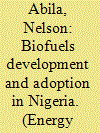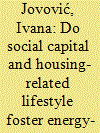|
|
|
Sort Order |
|
|
|
Items / Page
|
|
|
|
|
|
|
| Srl | Item |
| 1 |
ID:
112266


|
|
|
|
|
| Publication |
2012.
|
| Summary/Abstract |
Biofuels development and adoption in Nigeria has progressed significantly since the inception of the country's biofuel program in 2007. The rapid growth of the biofuels subsector in Nigeria inspired this review which aims at identifying the key drivers, agents, enablers, incentives and objectives driving the development. From the upstream to the downstream sub-sectors, there is an increasing entry of players and participants (private and public investors). This paper aims to explore the underlining drivers, enablers and incentives promoting the investments and participations in biofuels development, adoption and utilization in Nigeria. The research sourced data from basically secondary sources and undertook desk review of available information. The drivers identified are classified into the endogenous and exogenous categories. From the review, the paper presents a multi-components conceptual framework that captures key elements of the biofuel development in Nigeria.
|
|
|
|
|
|
|
|
|
|
|
|
|
|
|
|
| 2 |
ID:
191319


|
|
|
|
|
| Summary/Abstract |
This article explores the role of social capital and housing-related lifestyle in fostering energy-efficient retrofits and sheds additional light on potential barriers and drivers to energy-efficient retrofits in households. Using data from an online survey conducted in August 2020, a retrospective panel data set comprised of 2537 households from the EU member state of Slovenia is constructed. The results of discrete choice models with random effects show that high income levels, the respondent’s age, the age of the dwelling, previously performed retrofits, and the availability of subsidies are drivers, while high regional temperatures and negative GDP growth are barriers to energy-efficient retrofits. We find that social capital and housing-related lifestyle are also important determinants of energy-efficient retrofits. Certain dimensions of housing-related lifestyle, such as energy-saving behavior and a proclivity for ‘do-it-yourself’ home maintenance and repairs, act as drivers of energy-efficient retrofits. The same is true for variables related to social capital, namely, ease of agreement among residents and the formal organization of the building. A policy mix of further education and information campaigns, subsidies, and measures that affect the formal organization of the building and promote community building is required to address the various barriers to energy-efficient retrofits.
|
|
|
|
|
|
|
|
|
|
|
|
|
|
|
|
| 3 |
ID:
192839


|
|
|
|
|
| Summary/Abstract |
Scarce evidence postulates the drivers of eco-innovation in Latin American Countries. This paper aims to contribute empirically to the literature on drivers of eco-efficiencies in this region. We use the last year available in the new LAIS dataset -Latin American Innovation Survey- and apply multivariate probit models. Results show that drivers in this region can be divided into three groups: common, frequent, and occasional. The first one includes market and regulatory factors which affect the three countries; frequent drivers are some technological push drivers whose influence is substantial although only in some countries; and the last one refers to those drivers that have a sporadic effect on eco-efficiencies, such as training and cooperation. Differences also are found distinguishing by type of innovation -product and process, radical and incremental- and by efficiencies -energy, material, and environmental-.
|
|
|
|
|
|
|
|
|
|
|
|
|
|
|
|
| 4 |
ID:
080469


|
|
|
|
|
| Publication |
2007.
|
| Summary/Abstract |
Complex trade negotiations call for elaborate internal coordination and adept negotiating actors. In successful cases, these actors develop reciprocal dependent behaviors. Recent business and trade negotiation experiences testify to the development of process mechanisms in a variety of settings that demonstrate the capacity of the negotiators' role to expand. Constraints are acknowledged, essentially, the fact that the negotiator is a mandated agent and acts within a timebound context. Still, as drivers, negotiators practice their trade creatively to promote internal coordination, restructure the context, reframe and help solve micro-negotiation conflicts, and create conditions for the observance of reciprocating behaviors. The French term endroit is used to describe the venue in which collaborative negotiation is conducted
|
|
|
|
|
|
|
|
|
|
|
|
|
|
|
|
| 5 |
ID:
107493


|
|
|
|
|
| Publication |
2011.
|
| Summary/Abstract |
Since 2000, the United Kingdom has enthusiastically adopted marine wind energy as a potentially major source of electricity production and has become the leading nation in terms of output. This is in contrast to its relatively poor attainment of wind energy on land, and raises questions about the reasons for this difference in performance. This article traces the phases of development of marine wind energy in the UK with reference to factors that are instrumental in the uptake of this form of renewable energy. A number of features emerge from this analysis that stand in some contrast to the situation on land and help to explain the UK's current status. These include: recognition of an exceptional resource and relative ease of exploitation; government commitment and policy geared to controlled growth and strategic oversight, adequate economic support and start-up investment; the unusual rights and interests of the Crown Estate; and growing scale, confidence and organisation on the part of the industry. Set against these factors are the complexities of consenting, supply bottlenecks, and some stakeholder and public resistance, though these are outmatched by the drivers in favour of development and are being partly addressed.
|
|
|
|
|
|
|
|
|
|
|
|
|
|
|
|
| 6 |
ID:
131092


|
|
|
|
|
| Publication |
2014.
|
| Summary/Abstract |
The drivers of HIV/AIDS in the South African Police Service (SAPS) and impact of the disease on this workforce are neglected areas of research. Existing evidence suggests that while the occupational risk for contracting HIV is low, there are factors associated with the profession that, if left unmanaged, place police officers at risk of contracting HIV. This study's two aims are to identify the potential pathways of HIV infection within policing services and determine the probable impact of HIV/AIDS on SAPS. Through a systematic literature review on HIV/AIDS within police services, and by analysing selected SAPS human resource data, the causal pathways and impact of HIV/AIDS on police services are explored. The study finds that police officers (particularly male officers) are likely to be highly susceptible to HIV infection as a result of risky sexual behaviours born out of occupational characteristics such as high levels of stress, difficult working conditions, living away from home and interactions with sex workers. The problem is exacerbated by the 'macho' culture that often prevails among police officers. HIV/AIDS interventions within SAPS must focus on sustained behaviour change. Further, HIV programmes must equip officers with the knowledge and awareness to avoid engaging in high-risk sexual practices that may compromise their health and the effectiveness of the policing service.
|
|
|
|
|
|
|
|
|
|
|
|
|
|
|
|
| 7 |
ID:
150716


|
|
|
|
|
| Summary/Abstract |
Bavaria's energy policy seeks to increase the share of power supply from renewable sources related to on-farm energy production (agricultural biogas, wind- and solar energy) from currently 15% to more than 30% in 2021. It is therefore of particular interest for policy-makers to identify regional drivers of and barriers to this concept.
The presented study addresses this issue and applies a spatial regression analysis to Bavaria’s 71 rural counties. The findings indicate significant impacts of technological regional transformation ability, agricultural structure (degree of professionalization and consolidation of organic farming) and neighborhood effects. This is in contrast to most geographical factors, which seem to be of minor relevance.
|
|
|
|
|
|
|
|
|
|
|
|
|
|
|
|
| 8 |
ID:
166457


|
|
|
|
|
| Summary/Abstract |
The housing stock has a considerable share of 40% in energy consumption and 36% of emissions in the EU. In accordance to energy efficiency and emissions targets set by EU, The Netherlands has aimed to renovate 300,000 homes each year, leading to 50% reduction in emissions, by 2050. Many factors including low renovation rates create uncertainties in achieving these targets. The current study aims for understanding the barriers and drivers towards energy efficiency renovations (EERs) amongst Dutch homeowners, and to aid in gaining a better insight into the role of public authorities in promoting EERs. First, the extrinsic drivers, including policies and other initiatives in the EER process are explained. Second, the intrinsic drivers and intrinsic/extrinsic barriers are explored. Regression analyses are performed on the national Dutch survey data for renovators and potential renovators. Our main findings include: (a) desire to enhance the quality of their life, rather than the financial benefits, etc. is identified as the main driver; (b) the main barriers are the costs of EERs, complexities in the process, information barriers, and finding reliable experts and information; (c) For improvement in meeting renovation targets, the current Dutch policies need to consider all the decision criteria by homeowners, such as: Reducing the complexities; Time needed to obtain loans and subsidies; and Facilitating access to information.
|
|
|
|
|
|
|
|
|
|
|
|
|
|
|
|
|
|
|
|
|